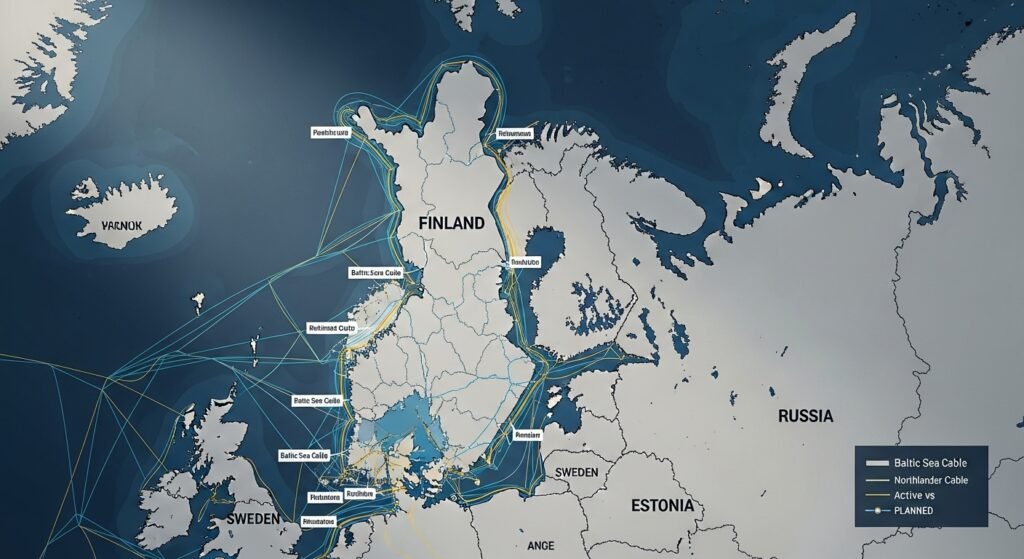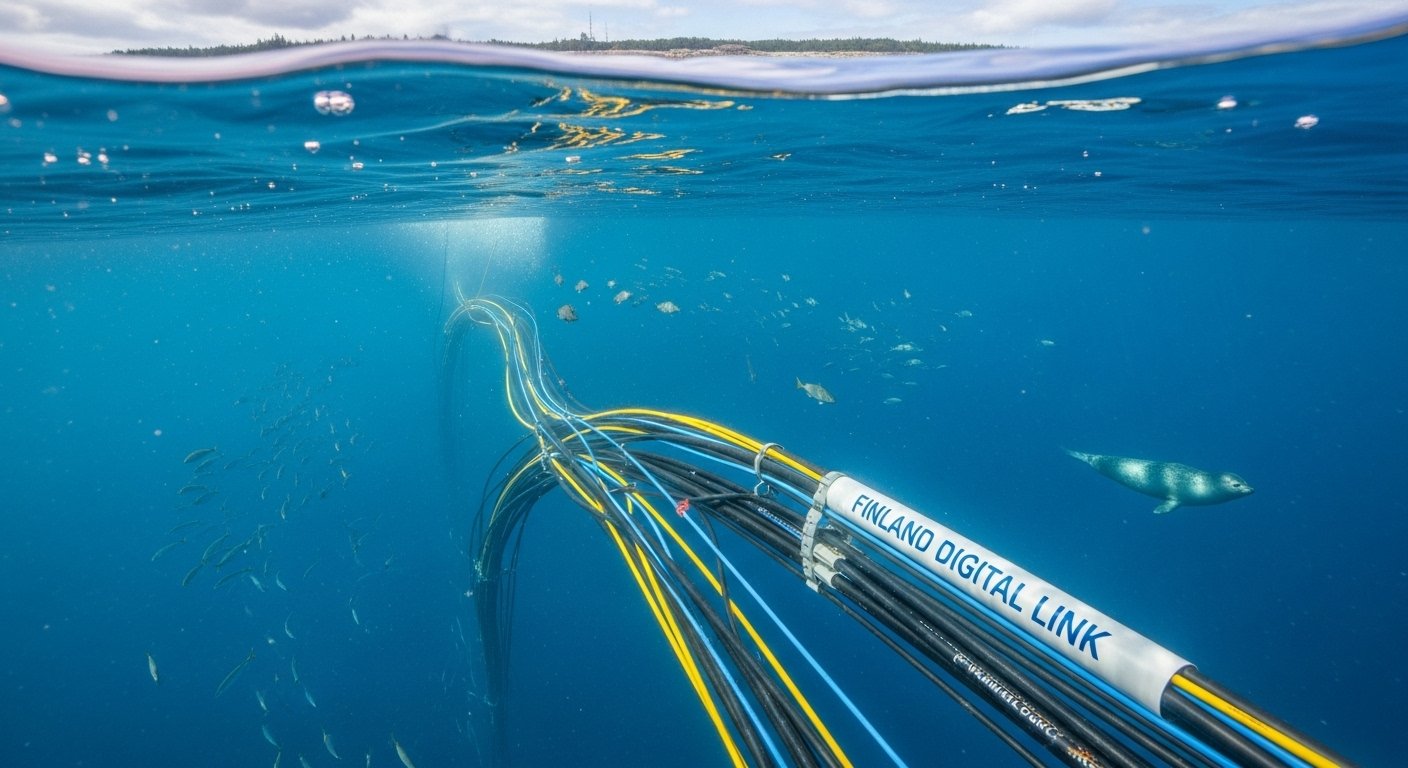Every time you load a website, send a message, or stream a video, data rushes behind the scenes at lightning speed. What many people don’t realize is that some of this internet traffic travels through massive underwater cables laid deep under the ocean floor. One of the lesser-known but very important parts of this vast system is the Finland undersea cables. These underwater cables help Finland connect with the rest of the world digitally. They support fast internet, secure communications, and global trade. In fact, these cables are now seen as critical infrastructure for technology, security, and national defense. This guide will take you on a journey to explore what the Finland undersea cables are, why they matter, who builds them, how they work, and what risks and protections are involved. Whether you’re a student curious about global internet setup, or just interested in how your phone works across the sea, this article is packed full of helpful and easy-to-understand information. Let’s dive in and learn how Finland plays its part in keeping the digital world connected.
What Are Undersea Cables?
Undersea cables, also called submarine cables, are long wires placed deep under the oceans. These cables carry signals that make internet, voice calls, and messages travel from one country to another. They are made from fiber optics, which use light signals to send huge amounts of data very fast and very far. Most of the global internet that crosses between countries rides on these cables. Even though we often think satellites do this work, more than 95% of international web data moves through undersea cables. The Finland undersea cables are a vital part of this global system, bridging the country with Europe, Asia, and beyond.
Why Are Finland Undersea Cables Important?
Finland undersea cables are very important because they help keep Finland connected to the rest of the world. These cables carry internet data, phone calls, business transactions, and even government information. They are the main roads for digital traffic under the sea. Since Finland is in the north of Europe and shares a long border with Russia, having secure and fast internet links is especially important. These cables also support Finland’s role as a growing tech hub, with data centers and companies that need strong international connections. Without these cables, access to global digital services would be much slower and far less reliable.
Where Do Finland’s Undersea Cables Connect?
Finland’s undersea cables connect to many neighboring countries. One major connection is to Sweden, a key European internet gateway. Other cables go toward Germany, Estonia, and even across the Arctic to Asia. The Finland undersea cables form a part of a bigger web known as the Nordics’ digital network. This helps countries share data, work together, and trade more easily. Some cables even stretch toward the United Kingdom and the Netherlands, which gives Finland better access to core European internet servers. Each connection means faster, safer, and more reliable data sharing for Finnish homes, schools, hospitals, and businesses.
Who Builds and Owns Undersea Cables?
Undersea cables are expensive and take years to plan and build. Many large companies, governments, or partnerships are behind them. For Finland undersea cables, builders include telecom giants, Nordic tech groups, and state-supported developers. The Finnish Transport and Communications Agency and private firms like Cinia and Telia have been involved in several underwater cable projects in Finland. Sometimes, international tech companies like Google, Microsoft, or Meta (Facebook) invest in cable projects that reach or pass through Finland to improve their cloud services. These groups often work together, sharing costs and managing the cables once they’re working.
How Are Undersea Cables Installed?
The process of installing Finland undersea cables is slow, precise, and done with the help of big ships. First, experts study the ocean floor using maps and remote tools. They look for mountains, rocks, and other things that could damage the cable. Once the safest route is found, cable-laying ships slowly move across the area, laying cables under the sea. In shallow waters, the cable is buried under the seabed to keep it safe. In deep waters, it rests on the ocean floor. Sensors and repeaters are placed along the cable to keep signals strong across long distances.
Protection and Security for Undersea Cables

The Finland undersea cables are part of the country’s critical digital infrastructure, which means we must protect them. Damaged cables can lead to blackouts in internet service, financial delays, or even national security risks. Finland works with international agencies, tech firms, and its armed forces to keep these cables safe from threats. Cable breaks are rare, but they can happen due to natural events like earthquakes, fishing activity, or even sabotage. That’s why cables often have backups or are part of wider networks with multiple routes. If one cable fails, traffic can move through others to keep the internet running.
How Do Undersea Cables Work?
Inside each Finland undersea cable are fiber optic strands—thin pieces of glass about the size of a human hair. These strands carry light signals that move data across thousands of kilometers. When you send an email or load a website, the data is turned into light and travels at nearly the speed of light through the fiber. Repeaters placed every 50 to 70 kilometers boost the signals. The journey might take just milliseconds, but behind the scenes, data flows through undersea cables, through land stations, and finally to your phone or computer.
Finland’s Role in Arctic Cable Projects
Finland is also involved in exciting new Arctic cable projects. These aim to connect Europe to Asia using a new route through the Arctic Ocean. The plan is to build one of the world’s fastest and most secure underwater cable systems. This would allow internet data to move between Asia and Europe while avoiding trouble spots like the Suez Canal or Middle East conflicts. The Finland undersea cables could position the country as a northern gateway for global data, boosting trade, tech, and defense partnerships with other nations.
How Undersea Cables Impact Business
The Finland undersea cables are not just for YouTube and email. They are critical for business. Companies rely on fast data to do emails, video calls, banking, cloud storage, and trade. Data centers in Finland use these cables to connect with clients abroad. As global businesses move online, fast and secure data routes are lifelines. Having stable undersea cable access makes Finland a better place to build tech companies. It also helps Finnish businesses trade smoothly with global partners. Without these cables, even small internet delays could hurt business productivity and customer service.
Undersea Cables and National Security
For a country like Finland, which shares a long border with Russia and plays a vital role in EU security, reliable internet is more than a business issue—it’s a matter of national defense. The safety of Finland undersea cables is taken very seriously. If a cable is cut or hijacked, it can stop communications, interrupt power control systems, or expose government data. That’s why the government and allied nations now treat undersea cable protection as top priority. New policies and contracts are being written with cable safety in mind. These cables are carefully monitored, and ships around them are tracked closely.
Environmental Considerations for Undersea Cables
Building Finland undersea cables also means respecting the ocean. Cable companies, governments, and marine experts work together to make sure marine life and water ecosystems are protected. Cables are often routed away from coral reefs and breeding grounds. Digging in shallow waters is done gently, with equipment that avoids damaging the seabed. Once cables are laid, they usually don’t harm sea creatures. In fact, studies show sea life often returns to normal quickly. Still, cable companies must follow strict rules and get approval before laying cables in any zones that affect sea life or fisheries.
The Future of Finland’s Undersea Cables
The future of Finland undersea cables looks promising and fast-moving. As internet use grows, so does the need for bigger, stronger cables. Finland is planning to build more connections, especially as demand for 5G, AI, video content, and cloud computing explodes. New projects will focus on speed, safety, and energy saving. Cables will carry more data, last longer, and offer smarter monitoring tools. Finland’s Arctic cable dreams are expected to speed up by the 2030s, bringing a new digital super-highway from Europe to Asia. Being ahead of the curve in cable tech could transform Finland’s digital economy for good.
FAQs
1. What are Finland undersea cables?
They are fiber optic cables placed under the sea that carry internet and data signals between Finland and other countries.
2. Are these cables important?
Yes, they help Finland connect with Europe and the world for fast internet, trade, and defense.
3. Can these cables break?
Yes, but it’s rare. When it happens, traffic is usually re-routed through backup connections.
4. Who builds Finland undersea cables?
A mix of private companies, tech giants, and Finnish government-supported projects build and maintain these vital data routes.
5. How deep are these cables placed?
They can be placed just below shallow seas or thousands of meters deep, depending on the location.
6. Why is Finland part of Arctic cable plans?
Finland offers a strategic northern path that links Europe to Asia with faster and safer data travel.
Final Thoughts
The Finland undersea cables may sit far beneath the waves, but their impact is felt across homes, businesses, hospitals, schools, and defense systems. They are the silent highways that keep our world connected. From checking emails to sending hospital data, these cables play a role in every part of life. As Finland invests in smarter digital routes—especially through the Arctic—the country is becoming a global leader in technology, communication, and security. For anyone interested in digital life, infrastructure, or global connections, understanding these cables isn’t just useful—it’s essential. The next time you send a message or stream a movie, remember, the ocean might be carrying it for you.






